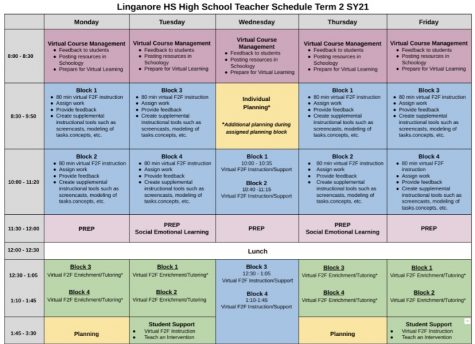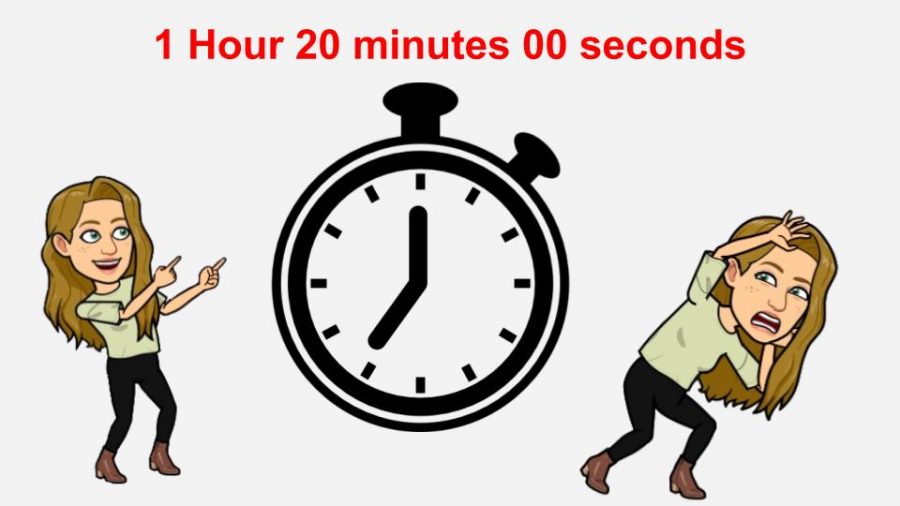Long Google Meets: Do they crush or help student learning?
Eighty minutes can seem like five hours.
Is 80 minutes too much time to be in virtual class or just enough?
November 30, 2020
Burning eyes, stiff neck, and wandering attention. Eighty minutes can seem like five hours when students are in a Google Meet. While sixty minute Meets were do-able, 80 minutes is too long.
Frederick County Public Schools (FCPS) announced on November 7 that teachers and students are required to stay in their Google Meet classes for 80 minutes. For many, including students and teachers, this is another step in the wrong direction.
Students are teachers who must stay online for the full block and are encouraged to use their cameras. The guidelines emphasized that active learning takes place daily, both for the synchronous meets and for the afternoon enrichment and tutoring.

Now with longer classes, that means more time staring at the Chromebook screen. It also takes away time to work on other assignments for other classes. With only five minutes between classes, that gives students barely enough time to use the bathroom and grab a snack. After that, there is another eighty minute class.
Sounds a lot like “real” school.
Having two eighty minutes classes back to back and then having PREP for thirty minutes, that added up to 190 minutes (3.167 hours) of just instructional work time. Then add on the amount of time the student has to look at the screen to complete the assignments, that’s about another two or three ours of screen time.
Dr. Ameera Nauman, a pediatric doctor, was interviewed by Kids Health and says it’s important to balance screen time with other healthy behaviors. She encourages that teens be active 15 minutes for every hour spent on a screen. She also encourages teens to limit their screen time to two hours a day, excluding homework. Also, according to Kids Health, screen time can contribute to obesity, attention problems, sleep disorders, and problems at school.
Yet, there are also positives to the change.
While the sophomores, juniors and seniors already had a taste of high school demands, this increase in time online can be helpful.
Class of 2024 member Aubrey Toothaker can see both sides, “I personally am not a fan of the 80 minute online, but it does give me a little more live instruction with my teachers, which is always helpful.”
“It gives us more time to do your own work rather than independently which gives us more time to ask questions and have them answered. My only problem is that I don’t get enough time in between classes anymore,” Class of 2024 member Anika Broadnax said.
Sophomores got the luxury of getting their freshman year out of the way. They got to experience the freshman year jitters and got to know the school building.
“My new schedule has definitely lowered my grades. The extra time in class helped with my government class, seeing as now we do work then,” Haley Lewis said.
Having longer classes can actually benefit the students and teachers. Teachers will have more time to give information to students and allow the teachers to give extra help to the students.
“My attention span has actually gotten better. I think that the longer classes have driven me to actually pay attention more,” Lewis said.
Teachers have been using a new feature on Google Meets called Breakout rooms. Breakout rooms allow students to be in pairs and small groups and collaborate on their assignments. Teachers can put time limits on the rooms, which allows the students to join their breakout rooms for specified time.
Principal Mrs. Hanlon said, “ I think, personally, it is a positive element increasing face to face ‘blue’ time in our virtual schedule. Teachers have more time with their students and can try some of the features available for collaboration like Polls, Breakout Rooms, and Jamboard to give students a chance to work together and interact with each other.
“Some classes where it may take longer to work through some complex material no longer have to rush through those complex problems. There is a little more breathing room to take some time to show the steps to those problems,” Hanlon added.
How did the FCPS BOE decide on the 80 minute classes?
Mrs. Jamie Aliveto, the Executive Director of System Accountability and School Administration (SASA) talked about how the county had surveyed families on virtual learning experiences and how they also had to follow the state’s requirements that there must be an average of three and a half hours of face to face hours for students and teachers of each grade.
“While the majority of the families indicated that the time their student was spending on virtual school was ‘just right,’ a number of families, particularly at the high school level, indicated their student should have more time in virtual instruction. We also heard from many high school staff members and some students who were concerned about not having enough time to teach or learn the full curriculum, particularly for students taking advanced coursework,” Aliveto said.
Mia Martinez is the Student Voice on the Board of Education and also attends Brunswick High School. “I’ve heard from many students that the 80 minute class periods are not ideal. Being in a virtual setting alone is hard enough for students to properly comprehend material. It has been my goal to echo this to the Board, which I have in past meetings. While I understand the idea of getting more face to face time, my peers mental health is a big concern of mine,” said Martinez.
With a combined total of 190 minutes or 3 hours and 10 minutes of required virtual school learning plus the extra time to do assignments, many students are looking at a screen for five hours a day just for school. Virtual learning can help improve the understanding of material given by the teacher and gives more time to work on problems with the teacher. It can also cut into students’ own individual time to do assignments.
How does the new 80 minute classes affect you?



